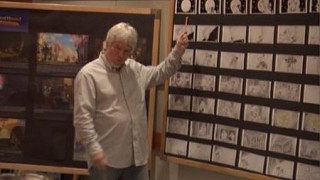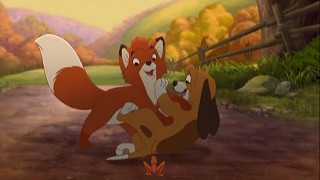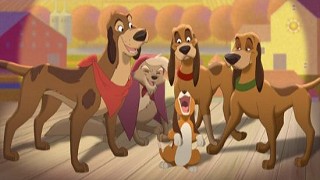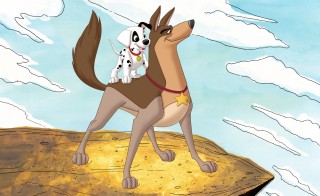
By Albert Gutierrez Jim Kammerud grew up on Disney cartoons and as an adult, formed his own animation company, doing work on films like Warner Brothers' 1996 hit Space Jam. He was soon approached to direct a sequel to a rather popular film about a half-fish-turned-fully-human. That film, of course, was The Little Mermaid, and the sequel was 2000's well-received The Little Mermaid II: Return to the Sea. Since then, Kammerud has co-written and directed 101 Dalmatians II: Patch's London Adventure (2003) and served as co-writer and co-producer of Tarzan II (2005). His latest directorial project is The Fox and the Hound 2, an all-new sequel that debuted on DVD earlier this week. Working on these Disney films has allowed Kammerud to travel internationally and collaborate with a great amount of talent from all corners of the world. He recently took some time to have a conversation with UltimateDisney.com about his career in animation and his newest film. UltimateDisney.com: Were you brought up on Disney films as a child? Were they a major influence in your decision to get into animation? Jim Kammerud: You know, The Jungle Book came out, and I couldn't wait to see it. I was born in 1960 and I thought the Nine Old Men were gods. How did you first become associated with Disney? I had a company in Columbus, Ohio, the Character Builders, and we started doing some work for them. I worked on about dozen feature films before that: Your main claims to fame have been as director for Little Mermaid II, 101 Dalmatians II, and now Fox and the Hound 2. But you were also a writer on 101 Dalmatians II and Tarzan II. What was that like, being on the writing side of production? Well, the great thing about writing something is you've already visualized the movie in detail and then you just have to go bring your imagination to life. On The Fox and the Hound 2, I worked a lot with Roger Schulman. It was great not to have to write, as he was doing a fabulous job. Recently, you went to Nashville for the premiere screening of The Fox and the Hound 2. How was that? Any of the voice cast there? Little Big Town [the country band that performs "We Go Together" in the film] was there, and they're just the nicest people, fun to be around. A lot of the musicians and songwriters who were on the film were there. We had some of the most amazing songs, and it was really fun to see them again. After the premiere, some young boy came up to me and shook my hand. He told me how great the movie was, and it made me cry. He was like, "You've made a really terrific movie, Mr. Kammerud!" Then we went to the Children's Hospital, and that was really moving too.
It's been 25 years since the original film premiered. What do you think prompted Disney to make the decision to continue the story? When you were in pre-production for The Fox and the Hound 2, was there any input or supervision from anybody who worked on the original film? Did the original animators come in to help out? Actually, Dave Block was an animator on the original film. I talked to Dave some and he went to the Philippines to travel there with me to talk to the animators there about how they animate Tod and Copper. So the film was animated in the Philippines? Mm-hmm. The crew there had a lot of television work, but my feature expectations are a lot higher and a lot different. It was pretty challenging for them, and they really came through. I really think they did a fabulous job, they worked so hard and did better than I ever expected them to do. I was surprised that a few of the characters from the original movie like Big Mama and Dinky weren't included in the sequel. Was it a story-dictated decision to omit them? Well, the film is...we don't spend a lot of time at home, right? Yeah, it's spent at the carnival. And we have a lot of new characters to introduce, so for better or worse, we just simplified things because we had the entire Singing Strays band that we wanted to hang out with. But we did have Tod and Copper chase around the cricket, which is similar to the little bug in first film. The caterpillar, right. But other than that, it really just wasn't necessary.
There is a generous amount of music in the movie, from both country singers and composer Joel McNeely. And you had several big name country stars provide vocals, even Reba McEntire as the voice of Dixie. What was it like being able to incorporate their talent in the film? Did you talk to them much about their characters? Yeah, sure. And it also was fun to have Patrick Swayze in there to show what Cash is going to be like. It's a collaboration, and I think the surprise for me was how great Reba was. Sometimes I get people who are big stars, you know movie stars, who are not really used to acting with their voices. But Reba... every sound that came out of her mouth was funny and perfect, or moving, and she's just amazing. Let's go back to The Little Mermaid II. The original recently came out to DVD as a Platinum Edition, and also with The Little Mermaid III coming out in 2008, do you think there's going to be some renewed interest in your film? Has Disney said anything about possibly re-releasing the film with your involvement? Yeah, wouldn't that be neat? But no, they haven't said anything to me about that. As one of the early sequels and one that followed such a high-profile film, were there high expectations for The Little Mermaid II when it was being made? And how did you feel about some of the criticism that was laid against the film? There have been criticisms about all the sequels, right? But that was the first Disney film that I directed, and it was such a challenge and so much fun to do that I was sort of oblivious to any (laughs) negative reaction that anyone had. I was just hanging on to the skin of my teeth to bring Melody alive. She has become such a great character and I'm really proud of her. To this day I have little girls tell me that's their favorite film. I'm like, "Well, really, you like the first film." They say, "No", which I think is funny.
After The Little Mermaid II, you worked on 101 Dalmatians II. I enjoyed that one's story in this one, as it wasn't a repeat of what we saw in the original. What was it like being able to do that kind of story for a sequel? Personally, if I could wave my magic wand, all the sequels would be new adventures or characters taken out of context of the original film. I’ve noticed that the animation style of 101 Dalmatians II, lines especially, are very reminiscent of the original, which used the Xerography process. It has very jagged lines, like the artists still had their pencil sketches there. Was that an intentional homage to the film or just a creative decision on your own? That was intentional. It was new technology - you can't really get the same pencil lines. It actually took additional work for clean-up artists, that was in Japan. They had to actually add the lines, add the hair bits. (laughs) The line quality made it feel fresh and spontaneous. We weren't doing a lot of colored lines, because that makes it look like a different movie. So if we just have hard black clean-up lines without the softening of the colored lines, it looks cheap. So even through all this new technology, I didn't want it to look like we weren't giving it our all, so the Japanese clean-up artists bailed me out. They came up with this technique that they could de-stress the lines. Last May, there was a listing on Internet Movie Database for The Aristocats 2 with you attached to direct. It has since disappeared. Was that really going to happen? I was working on that movie. I think it's not going to happen now. It was caught up in the transition in the studio, from 2-D to 3-D. What would that film have been about had it been produced? It was kind of Marie's story, a caper on a cruise ship. I really liked what we were doing, but I don't know if we should talk about it. (Laughs) But it was really great, maybe someday it will see the light of day. Are there any more Disney projects for you beyond The Fox and the Hound 2? Not this minute. It was wonderful talking to you. Thank you so much for taking out the time. I hope to see more of your work in the future, Jim. Sure, thanks a lot. |
Related DVDs - Jim Kammerud and Character Builders, Inc. Animation Highlights:
 |
 |
 |
 |
 |
 |
 |
 |
 |
| The Fox and the Hound 2 (2006) Review |
The Little Mermaid II: Return to the Sea (2000) | 101 Dalmatians II: Patch's London Adventure (2003) | Tarzan II (2005) Review |
Pocahontas II: Journey to a New World (1998) | The Hunchback of Notre Dame II (2002) | Space Jam (1996) (Two-Disc Special Edition) | Bébé's Kids (1992) | Rover Dangerfield (1991, VHS) |
Related DVD Review: The Fox and the Hound 2
UltimateDisney.com's Past Interviews:
Don Hahn, veteran Disney producer (October 2006) • Moira Kelly, the voice of Nala (December 2006)
Leonard Maltin, film critic/historian and author (December 2005) • Don Dunagan, the voice of Bambi (February 2005)
Irene Bedard, the voice of Pocahontas (May 2005) • Ilene Woods, voice of Cinderella, and producer Don Hahn (September 2005)
Michael Angarano, star of Sky High (November 2005) • Angela Robinson, director of Herbie: Fully Loaded (October 2005)
Priscilla Weems, star of "Five Mile Creek" (October 2006) • Jim Brickman, The Disney Songbook (October 2005)
Don Grady, former Mouseketeer, "My Three Sons" star, and current Disney musician (November 2005)
Taylor Lautner, Sharkboy of The Adventures of Sharkboy and Lavagirl in 3-D (September 2005)
Interview conducted December 15, 2006 by Albert Gutierrez. All images copyright Disney. Published December 16, 2006.
UltimateDisney.com | DVD Review Index | Disney's Direct-to-Video Movies Page | Search UltimateDisney.com





